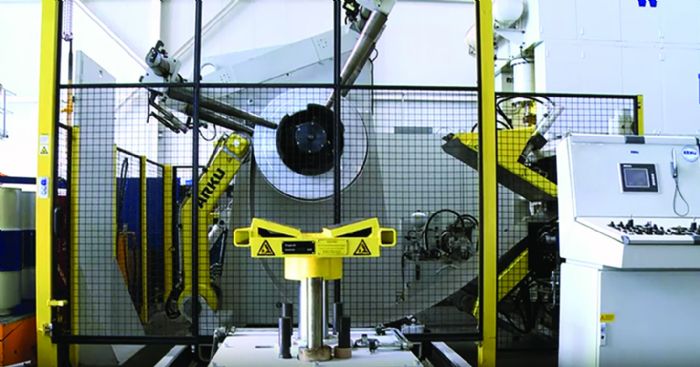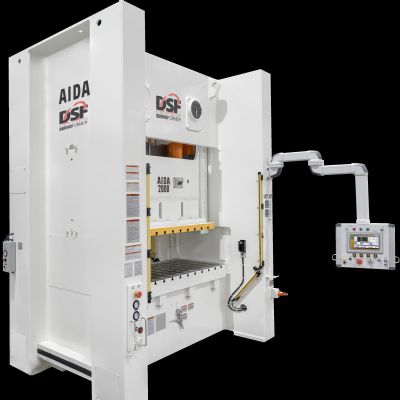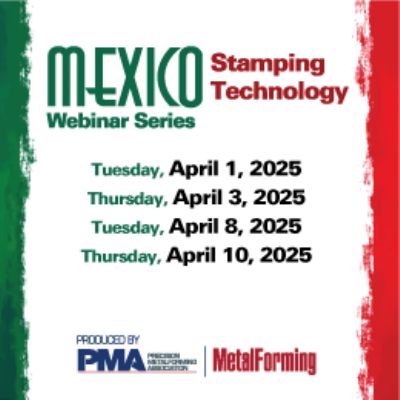Evolved to Handle the Task
When servo-driven presses first arrived in North America, material-feed suppliers assessed, and began supplying, solutions to better deal with the challenges described above. These included, for example, powertrain technology that improved acceleration and deceleration rates to achieve required strokes/min.
“Also improved: the lifting cycle for the pilot-release system on feed systems,” Hirschmann reports. “Depending on the type of tooling in the press—a progressive die, for example—metal formers had to ensure that the feeder remained open as the pin entered the material in order to position the material correctly in the die. This technology was required for each roll feeder, and for straightener-feeders in compact coil-feed equipment.”
Nowadays, metal formers have options when deciding on the right feed equipment for servo press lines. For its part, Arku has developed equipment ideally suited to servo press service, Hirschmann reports. This includes what Arku dubs a “long design,” containing a leveler, loop and roll feeder. It can include from nine to as many as 21 rolls, depending on flatness requirements. And, the company’s compact lines include a straightener and feeder, with a range of leveling cassettes.
“With these, we can employ from seven to 17 rollers, depending also on flatness specifications and material type,” Hirschmann says. “And, all of our feeders are designed to communicate with various types and brands of presses, relaying and accepting signals properly to ensure that feeders can achieve the performance required by metal formers.”
The automated nature of the latest servo presses, or of any stamping presses for that matter, also has resulted in feed-technology improvements.
“Servo presses possess high automation levels, meaning that they often enable automatic die changes, for example,” says Hirschmann. “Therefore, coil lines must have very short coil-change times, to limit downtime when transitioning from a strip end to a new strip. To accomplish this, metal formers should look for lines with automation that saves time when feeding the strip until it reaches the tooling. Remember, with each stoppage a press line is not producing parts.”
Feed-Shopping To-Do List
When looking to invest in press-feed equipment for servo press applications, flexibility is key, according to Hirschmann, to capture any applicable current or future work.
“Metal formers need a coil feed that can run a variety of materials,” he says. “To be open to possible work, look for good precision-leveling capabilities, because good results in leveling will ease forming and other operations in following processes. Less stress in the material, for example, improves tooling operation and results in higher-quality parts.”
For proper shopping, knowledge of currently used materials as well as materials that may inhabit the feed equipment in the future is invaluable.
“At Arku, we first request that metal formers fill out a questionnaire that includes information on coil weight, coil ID and OD, material thickness and the types of material that may run through the feed equipment,” Hirschmann says. “This helps greatly in assessing the required leveler and feed precision.”
From here, the feed-equipment supplier can propose possible equipment. Further discussion between the metal former and supplier may address other issues, such as the incorporation of blank loaders to maximize press working time. Finally, integration of a feed system into the press line is addressed.
“The goal for suppliers,” concludes Hirschmann, “is to make feeding as automatic as possible so that metal formers can get the most out of their servo presses.” MF
View Glossary of Metalforming Terms
See also: ARKU, Inc.
Technologies: Coil and Sheet Handling, Stamping Presses







 To better understand a proper match between feed and servo press, one must examine how servo presses will stress feed equipment.
To better understand a proper match between feed and servo press, one must examine how servo presses will stress feed equipment.


 Webinar
Webinar